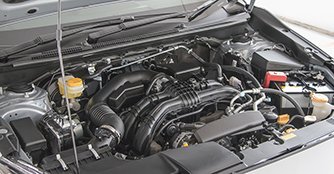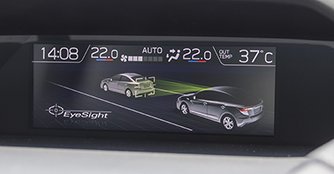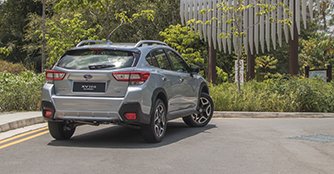Subaru XV 2.0i-S EyeSight (A) Review
28 Mar 2018|45,717 views
What We Like
Subaru EyeSight
2.0-litre engine is noticeably better than the 1.6-litre
High-quality cabin
Stylish exterior
Keen pricing
What We Dislike
CVT gearbox dampens the driving experience
Our biggest gripe with the second generation Subaru XV that we drove last year was the general lack of power from its 1.6-litre engine. Now, the 2.0-litre variant is finally available in Singapore. With additional power and the anticipated introduction of Subaru EyeSight, this variant has all the makings of a more refined and competent Sport Utility Vehicle (SUV).
More refined you say?
Let's jump straight into the differences, then. This variant packs a naturally aspirated 2.0-litre engine producing 154bhp and 196Nm of torque. Compared to the 1.6-litre engine, which produces a very modest 113bhp and 150Nm of torque, the 2.0-litre engine is certainly the better engine option. Acceleration is smoother and more refined, and pick up from low speeds is markedly better. Despite the car's weight, you never feel lacking in power (as you would do in the 1.6 variant).
The other big change is the introduction of Subaru EyeSight, the brand's suite of safety and driver assistance systems. In Singapore, the EyeSight package consists of five systems - lane departure warning, adaptive cruise control, lead vehicle start alert, pre-collision throttle management and pre-collision braking.

 The 2.0-litre Boxer engine produces 154bhp and 196Nm of torque, which is healthy enough for daily use
The 2.0-litre Boxer engine produces 154bhp and 196Nm of torque, which is healthy enough for daily use
On the road, we can report that the first three systems definitely work. Unfortunately, we aren't legally allowed to test the pre-collision throttle management and pre-collision braking on public roads, but in a closed-circuit session we did a few months ago, we can confirm that these systems work too.
What else is different?
Besides these changes, the rest of the car is pretty much identical to the 1.6-litre variant. Built on the Subaru Global Platform (SGP), the improved chassis rigidity translates to a better and more composed ride, along with improved noise insulation that delivers a more refined cabin experience.
More refined you say?
Let's jump straight into the differences, then. This variant packs a naturally aspirated 2.0-litre engine producing 154bhp and 196Nm of torque. Compared to the 1.6-litre engine, which produces a very modest 113bhp and 150Nm of torque, the 2.0-litre engine is certainly the better engine option. Acceleration is smoother and more refined, and pick up from low speeds is markedly better. Despite the car's weight, you never feel lacking in power (as you would do in the 1.6 variant).
The other big change is the introduction of Subaru EyeSight, the brand's suite of safety and driver assistance systems. In Singapore, the EyeSight package consists of five systems - lane departure warning, adaptive cruise control, lead vehicle start alert, pre-collision throttle management and pre-collision braking.

On the road, we can report that the first three systems definitely work. Unfortunately, we aren't legally allowed to test the pre-collision throttle management and pre-collision braking on public roads, but in a closed-circuit session we did a few months ago, we can confirm that these systems work too.
What else is different?
Besides these changes, the rest of the car is pretty much identical to the 1.6-litre variant. Built on the Subaru Global Platform (SGP), the improved chassis rigidity translates to a better and more composed ride, along with improved noise insulation that delivers a more refined cabin experience.
The XV also handles well, thanks to the SGP as well as a well-sorted suspension setup. Compared to its competitors from Honda or Toyota, the XV is definitely the best-driving of the lot. Of course, having all-wheel drive greatly helps in delivering at-the-wheel confidence when cornering.
The one dour aspect of the XV is its continuously variable transmission gearbox, which dulls the overall sensation of sportiness.
Should I buy one?
Overall, this XV 2.0 feels like the more complete and refined package compared to the 1.6. It is stylish, practical and comfortable, thus ticking all the boxes an SUV needs to. It also drives well and is well-equipped. At its very competitive $99,800 price point (as of 26 March 2018), it represents good value for money, at least as far as sticker price goes.
The obvious downside is that this car will be more expensive to run over time - fuel consumption isn't great, and the larger capacity engine translates to a heftier road tax.
Still, if you're in the market for a Japanese SUV, the XV is hard to overlook. With its marked improvements in overall quality, refinement and style, it still manages to stand tall among its competition.
The one dour aspect of the XV is its continuously variable transmission gearbox, which dulls the overall sensation of sportiness.
Should I buy one?
Overall, this XV 2.0 feels like the more complete and refined package compared to the 1.6. It is stylish, practical and comfortable, thus ticking all the boxes an SUV needs to. It also drives well and is well-equipped. At its very competitive $99,800 price point (as of 26 March 2018), it represents good value for money, at least as far as sticker price goes.
The obvious downside is that this car will be more expensive to run over time - fuel consumption isn't great, and the larger capacity engine translates to a heftier road tax.
Still, if you're in the market for a Japanese SUV, the XV is hard to overlook. With its marked improvements in overall quality, refinement and style, it still manages to stand tall among its competition.
What We Like
Subaru EyeSight
2.0-litre engine is noticeably better than the 1.6-litre
High-quality cabin
Stylish exterior
Keen pricing
What We Dislike
CVT gearbox dampens the driving experience
Our biggest gripe with the second generation Subaru XV that we drove last year was the general lack of power from its 1.6-litre engine. Now, the 2.0-litre variant is finally available in Singapore. With additional power and the anticipated introduction of Subaru EyeSight, this variant has all the makings of a more refined and competent Sport Utility Vehicle (SUV).
More refined you say?
Let's jump straight into the differences, then. This variant packs a naturally aspirated 2.0-litre engine producing 154bhp and 196Nm of torque. Compared to the 1.6-litre engine, which produces a very modest 113bhp and 150Nm of torque, the 2.0-litre engine is certainly the better engine option. Acceleration is smoother and more refined, and pick up from low speeds is markedly better. Despite the car's weight, you never feel lacking in power (as you would do in the 1.6 variant).
The other big change is the introduction of Subaru EyeSight, the brand's suite of safety and driver assistance systems. In Singapore, the EyeSight package consists of five systems - lane departure warning, adaptive cruise control, lead vehicle start alert, pre-collision throttle management and pre-collision braking.

 The 2.0-litre Boxer engine produces 154bhp and 196Nm of torque, which is healthy enough for daily useOn the road, we can report that the first three systems definitely work. Unfortunately, we aren't legally allowed to test the pre-collision throttle management and pre-collision braking on public roads, but in a closed-circuit session we did a few months ago, we can confirm that these systems work too.
The 2.0-litre Boxer engine produces 154bhp and 196Nm of torque, which is healthy enough for daily useOn the road, we can report that the first three systems definitely work. Unfortunately, we aren't legally allowed to test the pre-collision throttle management and pre-collision braking on public roads, but in a closed-circuit session we did a few months ago, we can confirm that these systems work too.
What else is different?
Besides these changes, the rest of the car is pretty much identical to the 1.6-litre variant. Built on the Subaru Global Platform (SGP), the improved chassis rigidity translates to a better and more composed ride, along with improved noise insulation that delivers a more refined cabin experience.
More refined you say?
Let's jump straight into the differences, then. This variant packs a naturally aspirated 2.0-litre engine producing 154bhp and 196Nm of torque. Compared to the 1.6-litre engine, which produces a very modest 113bhp and 150Nm of torque, the 2.0-litre engine is certainly the better engine option. Acceleration is smoother and more refined, and pick up from low speeds is markedly better. Despite the car's weight, you never feel lacking in power (as you would do in the 1.6 variant).
The other big change is the introduction of Subaru EyeSight, the brand's suite of safety and driver assistance systems. In Singapore, the EyeSight package consists of five systems - lane departure warning, adaptive cruise control, lead vehicle start alert, pre-collision throttle management and pre-collision braking.

What else is different?
Besides these changes, the rest of the car is pretty much identical to the 1.6-litre variant. Built on the Subaru Global Platform (SGP), the improved chassis rigidity translates to a better and more composed ride, along with improved noise insulation that delivers a more refined cabin experience.
The XV also handles well, thanks to the SGP as well as a well-sorted suspension setup. Compared to its competitors from Honda or Toyota, the XV is definitely the best-driving of the lot. Of course, having all-wheel drive greatly helps in delivering at-the-wheel confidence when cornering.
The one dour aspect of the XV is its continuously variable transmission gearbox, which dulls the overall sensation of sportiness.
Should I buy one?
Overall, this XV 2.0 feels like the more complete and refined package compared to the 1.6. It is stylish, practical and comfortable, thus ticking all the boxes an SUV needs to. It also drives well and is well-equipped. At its very competitive $99,800 price point (as of 26 March 2018), it represents good value for money, at least as far as sticker price goes.
The obvious downside is that this car will be more expensive to run over time - fuel consumption isn't great, and the larger capacity engine translates to a heftier road tax.
Still, if you're in the market for a Japanese SUV, the XV is hard to overlook. With its marked improvements in overall quality, refinement and style, it still manages to stand tall among its competition.
The one dour aspect of the XV is its continuously variable transmission gearbox, which dulls the overall sensation of sportiness.
Should I buy one?
Overall, this XV 2.0 feels like the more complete and refined package compared to the 1.6. It is stylish, practical and comfortable, thus ticking all the boxes an SUV needs to. It also drives well and is well-equipped. At its very competitive $99,800 price point (as of 26 March 2018), it represents good value for money, at least as far as sticker price goes.
The obvious downside is that this car will be more expensive to run over time - fuel consumption isn't great, and the larger capacity engine translates to a heftier road tax.
Still, if you're in the market for a Japanese SUV, the XV is hard to overlook. With its marked improvements in overall quality, refinement and style, it still manages to stand tall among its competition.
Also read our comparison article on:
Honda HR-V 1.5 vs Skoda Karoq 1.5 vs Subaru XV 2.0i-SCar Information
Subaru XV 2.0i-S EyeSight (A)
CAT B|Petrol|14.3km/L
Horsepower
115kW (154 bhp)
Torque
196 Nm
Acceleration
10.4sec (0-100km /hr)
This model is no longer being sold by local distributor
All Used Subaru XVThank You For Your Subscription.











































